...ABC Exclusive
...Artcell...Black...Cryptic
Fate...
By
Chowdhury Rashaam Raiyan
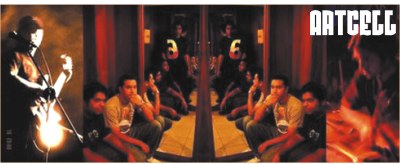 Note:
Shaju- drummer (Artcell), Jahan-guitarist (Black) and Shakib-vocalist
(Cryptic Fate) are the one's answering on behalf of their bands, but
in some cases the views expressed are more personal, rather than the
'over-all' perspective of their respective bands…How's life?
Note:
Shaju- drummer (Artcell), Jahan-guitarist (Black) and Shakib-vocalist
(Cryptic Fate) are the one's answering on behalf of their bands, but
in some cases the views expressed are more personal, rather than the
'over-all' perspective of their respective bands…How's life?
Shaju(Artcell):
Having the best time of my life! Just graduated…and leading a BEKAR
life...ha ha ha!
Jahan (Black):
On the run, chasing dreams. Desperately need some NOS for my engine!
Shakib(Cryptic
Fate [CF]): Life is great. I've got a job in an advertising firm and
in my spare time I play cricket, do music and hang out with friends.
Benson
and Hedges has been an integral part of the spread of 'band music'
in Bangladesh from the late 90s and have sponsored various 'youngster'
hangouts. What are your feelings about this not only as musicians
in Bangladesh but also as icons that young people look up to?
Artcell: Obviously
B&H is doing a great job with the 'Youngster' hangouts. But I'm
not quite sure about their contribution to the music scene. Maybe
it's because I'm a latecomer in the music scenario. All I saw from
them is the 'Star Search' thing. And quite frankly I don't see any
real 'Star' coming out from there. Where are Vikings and Stealers
now? Has B&H backed them up much? There should have been a lot
of concerts organized by them featuring their "Stars". You
started the process now finish it properly! Well, than again it's
just my personal point of view. I may not know some things and that's
probably why I'm looking at this from a different angle.
Black: Unlike
any other sponsors, they have succeeded in setting a standard in sponsoring
musical events or public hangouts, which are surely worth enjoying.
Whatever they do, they do it bigger and better. But it's a pity that
all of their events are planned only for their age restricted target
market (above 18 years of age). I support their initiative, which
promotes art, music and fashion but I definitely do not support the
product they are selling.
CF: The entire
B&H contest and everything is a great platform for young musicians.
It is the only formal event that recognizes band music and lets young
people from all over the country realize their dreams. As in any event
in Bangladesh, there are both good and bad things associated with
it but on the whole I am all for the B&H Star Search (even though
I failed in it twice, once with Cryptic Fate and the next time with
Watson Brothers).
Different
'aspects' attract people to music, what is it for each of you?
Artcell: I don't
know about others, but for me it's the thrill of playing LIVE in front
an audience, who are enjoying and appreciating the music, head banging
etc. I used to see Metallica, Pantera live concerts and just dreamt
of playing on stage like them!
Black: Never thought
of it…none of our parents relate to this, so can't say it's by birth
either…Lets say…it just...happened...naturally!
CF: Playing music
was a rush. That's what attracted us at first. But soon we realized
that making our own music was even more of a rush and that's what
kept the attraction alive for so many years. Another reason is that
we believe we are damn good at doing music and we want to be remembered
long after we're dead as significant contributors to Bangla Rock.
What
is the main difference between mainstream and underground (UnGr) musicians?
Black: For a mainstream
musician priority #1 is his music director's satisfaction #2 How the
listeners will respond to it ("khabe ki khabe na?") #3 Whether
it will be worth his remuneration #4 His own satisfaction as a musician
(never fulfilled) and #5 his contribution to Bangla music (a very
few think of it).
And for an UnGr
musician priority #1 is- doing good music...smartly and getting recognized
#2 His own satisfaction #3 Proving himself to friends, family, a number
of audiences and to himself too #4 Contributing something to Bangla
music and taking music as a career.That explains it all but opinions
may vary.
CF: Mainstream
musicians support themselves with their music. That is their job,
they make a living from music. Thus they always have to make music,
which they think will sell. They cater to popular trends. Underground
musicians do music as a hobby, so they have the freedom to create
the kind of music that they want to listen to.
We
know very little about the emergence of the UnGr music scene in Bangladesh…Can
you tell us how it started…and your personal experiences in it?
Artcell: I know
about this underground scene from '97,'98. At that time PG auditorium
was holding a series of underground metal shows quite regularly. Sometimes
3/4 concerts a month! At that time most bands were Heavy metal bands.
There were bands like Cryptic Fate, Koprophilia, Dethrow, Psychodeath,
X-uranium, Tantrik, Clovermind and many others. They mostly covered
songs from Metallica, Megadeth, Slayer, Pantera, Sepultura, and these
sorts of metal bands. There was not much of Alternative rock. Only
pure heavy stiffs. (I even remember in one concert a band named "Spanking
Monkies" covered Smells like Teen Spirit, and some other alternative
songs, and we were like, "What the...?" We didn't pay this
much to see these!) No hard feelings to anyone, but the scene was
like this at that time. But those golden times didn't last for long,
as PG refuses to hold any more shows as they ended up with broken
chairs after every show. After that the scene had a break, as there
were shortage of venues.
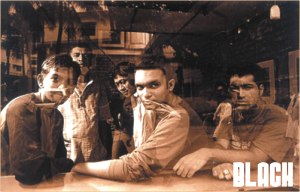 Meanwhile,
I got inspired by all those shows, 'cause I listened to metal all
my life, but had no idea about people covering them here in Dhaka
city! With that inspiration I started to learn drums and got fortunate
enough to work with my current band mates. But that's a totally different
story, the formation of the band Artcell. Well after Artcell was born
we had our first show in ICMA auditorium in Katabon. We covered Unforgiven
2 and one song from Garage inc. (can't remember the name) of Metallica
and Inner Self and Propaganda from Sepultura. Well that's our start
in the underground scene.
Meanwhile,
I got inspired by all those shows, 'cause I listened to metal all
my life, but had no idea about people covering them here in Dhaka
city! With that inspiration I started to learn drums and got fortunate
enough to work with my current band mates. But that's a totally different
story, the formation of the band Artcell. Well after Artcell was born
we had our first show in ICMA auditorium in Katabon. We covered Unforgiven
2 and one song from Garage inc. (can't remember the name) of Metallica
and Inner Self and Propaganda from Sepultura. Well that's our start
in the underground scene.
CF: It all started
in the 70s with Azam Khan and really this is a HUGE topic. Bands like
LRB, Miles, Feedback were all "underground" in the beginning
and created fantastic music. But then they all went commercial. UnGr
music resurfaced in late 80s and early 90s with bands like Rockstrata
and Warfaze. There was another resurgence in the late 90s with Dethrow,
Psychodeth, Koprophilia, and of course my own band Cryptic Fate. My
personal experience is that the best time to be an underground band
is now, because of the enormous support from people like Sumon Bhai,
Duray Bhai and Khaled bhai of G-series (cassette production company).
Plus, we have great studios now that we didn't have 5 years back.
As for my personal experience, it's been tough and frustrating for
a long time but the last 2 years have been amazing and as I have already
mentioned, this is a good time to be an underground band!
Inspiration,
Originality, and Copying…Bangladeshi music has always taken from western
music (like the great Tagore himself) and it has been a source of
enriching our creativity over the years, so why is it that now, when
something remotely resembles western stuff…it comes under intense
scrutiny from all sides?
Artcell: I've
noticed that, nowadays, some people have this weird tendency of always
trying to find from where 'this' song has been copied. I mean they
can't just be happy to accept the fact that this can be something
of 'this' band's original work. Maybe this is because they don't have
enough faith on us. But here I'm talking about a very small number
of people. Other than that, I'll say all of our fans enjoy our music
and appreciate it.
Black: We call
it cultural exchange. But when the "exchange" becomes one-sided
and turns "following blindly" then the 'credit' goes entirely
to the ever-expanding TV media and internet which also made us "culture-conscious"
too. The common people are more aware now than the times of Tagore.
So it is very obvious that the slightest resemblence will come under
discreet scrutiny from the 'overreacting-newly-culture-conscious'
minds.
CF: This is because
we've seen most of the great bands of Bangladesh copy music from western
bands over the years. It has happened so often that now we have this
idea that Bangalis are incapable of world-class original creation.
There's
a common 'misconception' that those who come into band music, come
from relatively high socio-economic backgrounds, and thus, cannot
produce music for the 'masses' in Bangladesh, where over 40% of the
people live below the poverty line. Is this the reason for the successful
UnGr musicians to remain UnGr or at a maximum stay popular at a more
urban level but not at a rural one?
I think the whole
band music is targeted to Urban, semi-urban level. It's not for rural
people anyway. So I think we are not intended to produce music for
the 'masses'. And the type of music we the UnGr musicians are doing,
are not even for all the band music listeners. So it is very unlikely
for us to be a big hit in the market.
Black: To enjoy
the music we produce, the listener must have a listening background.
One can't jump from pure, raw folk to heavily sounded prog rock or
alt rock overnight. That's why the folk remixes are so popular all
over the country. It's not that we can't do music for the mass. It's
about TASTE. We'd like to change the taste of the listeners rather
than changing ours by giving them quality music of a different taste.
That'll take time to digest. But we feel the change already watching
the response of the audience when we do live concerts outside Dhaka.
CF: Not at all,
"Bangla" is a great example of high society people producing
music for the masses. However, most UnGr bands are into rock or metal,
very complex forms of music and not easily understood. This is a worldwide
phenomenon, which is why Brittney Spears sells more than Tool. This
is a situation where the UnGr bands will have to persevere and "teach"
the masses the joys of modern complex music, rather than "dumbing
down" their style for the masses.
Does
rivalry exist between bands in the UnGr music scene?
Artcell: I think
that 'Rivalry' is not the proper word, but the word 'competition'
fits in best. Well there is some and there should be some. Because
of this competition we have and will be better musicians and bands
in the future from this underground scene.
CF: The underground
bands I hang out with are Aurthohin, Artcell and Black (although Aurthohin
is not strictly underground). We are all great friends and although
there is a friendly rivalry between us it is a positive thing.
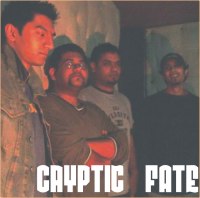 We
are all great friends, we are always there for each other and love
working together. The ABC song "Aashirbaad" in the album
Dinbodol is a great example of how Artcell, Black and Fate work together.
I don't know much about the other bands in the underground but hope
that ABC's friendship can be some sort of an example.
We
are all great friends, we are always there for each other and love
working together. The ABC song "Aashirbaad" in the album
Dinbodol is a great example of how Artcell, Black and Fate work together.
I don't know much about the other bands in the underground but hope
that ABC's friendship can be some sort of an example.
This is a typical
question…but what advice do you have for young aspiring musicians…
Artcell: Listen
to a lot of music. 'good music'!!! And practice a lot. Be a musician
first before you form any band.
Black: Know your
roots, follow your heart and try to express your true self and your
feelings through music. Because music is not only about listening
and enjoying, it is also about feelings and experiencing life aesthetically
CF:
Please get your basics right. Listen to the right bands and understand
music theory. Pick up songs in their entirety because that is the
best way to understand music theory. And practice, practice, practice.
And play cricket in your spare time.
Lord of the Rings:
Battle for Middle-earth
Rising Stars rating
8.4
By
Niloy
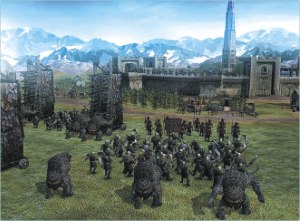 The
Lord of the Rings: Battle for Middle-earth is stylistically consistent
with the movies and is presented with style and polish. While that
portion of the game is excellent, the rest of it is simply decent.
While it's fast and can certainly be fun, there's just something missing
in the gameplay to categorize it as amazing. Even so, I had an enjoyable
time playing Battle for Middle-earth and I think LOTR fans will as
well, even if the story isn't totally consistent.
The
Lord of the Rings: Battle for Middle-earth is stylistically consistent
with the movies and is presented with style and polish. While that
portion of the game is excellent, the rest of it is simply decent.
While it's fast and can certainly be fun, there's just something missing
in the gameplay to categorize it as amazing. Even so, I had an enjoyable
time playing Battle for Middle-earth and I think LOTR fans will as
well, even if the story isn't totally consistent.
Let me explain…Earlier
on in the game, I rescued Boromir from his death on the shores of
the Anduin, and he's been bravely fighting alongside the forces of
Gondor ever since; and Gandalf never fell to the whip of the Balrog
in Moria, because Aragorn stuck the bugger with his sword first. Saruman
is running around with a group of orcs somewhere near Minas Tirith
casting powerful battlefield spells, Sam had the assistance of a number
of the guards of Gondor when he handed Shelob her arse on a plate,
and oh - that Balrog I mentioned? I just summoned it to kick about
some foes in the fields of Rohan.
If you're not
getting the hint yet, what I'm saying is this: if you're a Lord of
the Rings purist, look away now. If you have ever been known to make
a statement like "the removal of the scouring of the Shire ripped
the narrative and moral heart from Tolkien's vision!", then do
not seek out this game. Seek professional help instead. If, on the
other hand, you just loved the epic fantasy of the trilogy and think
that the idea of leading the armies of Middle-Earth into mortal combat
sounds like your cup of tea - step right up.
Basing a real-time
strategy game on a movie is a concept which looks loaded with difficulty,
but EA focused on what will make a good game rather than on fitting
in exactly with the plot of the trilogy. That's a good move. Freed
from the restrictions which seem to be imposed on most other movie
tie-ins, Battle For Middle-Earth does throw up some peculiarities
such as suspiciously resurrecting heroes and fictionally unlikely
Balrog summoning, but in return it offers a genuinely compelling game
which benefits hugely from its epic setting and the player's familiarity
with the universe and characters, rather than being held back by it.
Four unique sides
are playable in the game - the kingdoms of Rohan (which has incredibly
powerful cavalry, as you'd expect) and Gondor (great defensive capabilities),
and the evil forces of Mordor and Isengard, which are largely focused
on swarming the enemy with wave after wave of orcs, and also have
access to powerful siege units such as those bloody great elephant
things. Aerial support is provided by giant eagles and by Nazguls,
and each side has a bunch of hero characters at their disposal, most
of whom are indeed disposable, and whose influence can often swing
the progress of a battle.
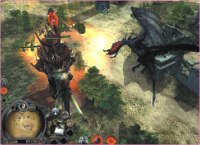 The
campaign game is played out on a large 3D map of Middle-Earth, which
is divided up into a set of provinces. You move your armies (up to
three of them) around this map, dropping into each province individually
to fight through a battle - leading to the capture of the province,
and effectively giving you control over the course of the campaign,
although occasionally you'll be called upon to fight through a specific
part of the plot. These plot-specific parts (including the Fellowship
going through the Mines of Moria, or fighting the Uruk-Hai at the
Anduin, or the climactic siege of Minas Tirith) will sometimes give
you control simply of a small group of heroes and task you with keeping
them alive - an odd departure from their normal expendability, and
arguably one of the weakest elements of the game. When will RTS creators
learn that taking a couple of units through a mission simply isn't
as much fun as controlling an army?
The
campaign game is played out on a large 3D map of Middle-Earth, which
is divided up into a set of provinces. You move your armies (up to
three of them) around this map, dropping into each province individually
to fight through a battle - leading to the capture of the province,
and effectively giving you control over the course of the campaign,
although occasionally you'll be called upon to fight through a specific
part of the plot. These plot-specific parts (including the Fellowship
going through the Mines of Moria, or fighting the Uruk-Hai at the
Anduin, or the climactic siege of Minas Tirith) will sometimes give
you control simply of a small group of heroes and task you with keeping
them alive - an odd departure from their normal expendability, and
arguably one of the weakest elements of the game. When will RTS creators
learn that taking a couple of units through a mission simply isn't
as much fun as controlling an army?
The overview map
itself is very simple, but it serves its role well and as a plus point,
it's beautifully modelled and animated. Each province that you capture
boosts your power, giving you special abilities such as the ability
to summon Elvish allies in battle, boosting your production rate or
simply raising the cap on the number of units you can have at your
command. In one of the nicest touches in the game, the armies you
create are also persistent, so the force you end one battle with is
by and large the same as the force you start with next time around,
and normal units as well as heroes level up and gain experience. You
can even rename your regular units, giving your army that rather more
personal touch.
This aspect leads
to some of the finest moments in the game - such as the level where
you defend Helm's Deep from invaders, up to the point where you are
rescued by the appearance of Eomer's army of horsemen - the very army
which you've just spent several missions assembling on the plains
of Rohan. It also gives rise to a particularly gruesome aspect of
the evil forces in the game - when playing as the forces of Mordor
or Isengard, you can order your own units to kill each other in order
to boost their experience, which is a cunning way to exploit the tendency
of the unit production cap to leave you with far more resources than
you can possibly spend.
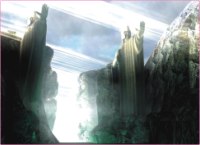 Once
the game gets going, it's incredibly spectacular. Although this is
no Rome: Total War, the clever decision to make each unit into a group
of five men (or ten orcs for the swarm-happy Dark forces) means that
you still end up with epic scale battles, and watching a set of siege
elephants bearing down on the gates of Minas Tirith is a scene to
stir the heart of any RTS player. Graphically, Battle for Middle-Earth
is one of the best looking strategy games out there; it can strain
a little when there are too many units on screen, but in general it's
an impressive feast for the eyes, with every major location from the
movies recreated in loving detail.
Once
the game gets going, it's incredibly spectacular. Although this is
no Rome: Total War, the clever decision to make each unit into a group
of five men (or ten orcs for the swarm-happy Dark forces) means that
you still end up with epic scale battles, and watching a set of siege
elephants bearing down on the gates of Minas Tirith is a scene to
stir the heart of any RTS player. Graphically, Battle for Middle-Earth
is one of the best looking strategy games out there; it can strain
a little when there are too many units on screen, but in general it's
an impressive feast for the eyes, with every major location from the
movies recreated in loving detail.
While
EA's use of the Lord of the Rings franchise to date has largely been
fairly impressive, the direct movie tie-ins have all been quite shallow.
Battle for Middle-Earth, however, would be an impressive game even
if it weren't based on Lord of the Rings. It's a clever and well-constructed
strategy title with plenty of innovation of its own, and a genuinely
great use of the franchise. Easily the best of the Lord of the Rings
games to date, it also comes well recommended as one of the best PC
strategy games of 2004.
Sites
Unseen
By Niloy
 Gmail
invites anyone? I'm giving out Gmails again. No limitations this time,
everyone who asks for an account will get one!
Gmail
invites anyone? I'm giving out Gmails again. No limitations this time,
everyone who asks for an account will get one!
Floating Logos
http://www.siberart.com/signs%20pages/logos_home.html
First, let's make this clear: The logos aren't really floating. Through
the miracle of digital enhancement, the photos have been altered to
remove the posts and poles that keep the signs in the air, giving
them the eerie appearance of gravity-defying weightlessness. Without
any visible means of support, even McDonald's signs take on a ghostly
quality. Though most of the logos designate fast-food outlets and
gas stations, this sign seems some how appropriate floating above
the Earth.
Microsoft's Anti-Spyware
http://tinyurl.com/5p7co
Microsoft has stepped into the anti-spyware arena with a fast and
useful tool. It's still in beta, but it already ranks as one of the
best anit-spyware around.
Bullies for hire
http://www.eastsidemall.com/bulliesforhire/bullies.html
A service that lets you to hire bullies to bully your children.
Peace Art Project Cambodia
http://www.peaceartprojectcambodia.org/
Even the first few years of the new millennium have been a big bust
world peace-wise, some folks still insist on keeping hope alive. In
the finest tradition of beating swords into forks and spoons, 23 University
students from Columbia have been trained to sculpt in a unique medium
-- decommissioned weapons. No shortage of material here; after more
than 30 years of civil war, ending in 1998, the Cambodian government
destroyed 125,000 weapons across the country. The students have secured
thousands of these, including guns, tripods, mine casings, and destroyed
ammunition. A look at the sculpture gallery shows the results: machines
meant for killing transformed into such peaceful and useful objects
as a bicycle, stool, and even a doggie.
Be a GOD for a while
http://www.jraxis.com/atheism/simulator/
A "God Simulator" that dares to poke fun at the Almighty.
Sam's Mailbox Picture Collection
http://sblom.com/mailbox/
Is anything more indicative of the human spirit and mankind's eternal
quest for beauty than a lovingly crafted mailbox in the shape of a
cow? Whatever your answer, you can still enjoy Sam's storehouse of
the most bizarre mailboxes on the planet. Apparently, some people
like to receive their TV Guides and credit card bills in something
a little more complex than the traditional lunchbox-shaped container.
Sam has done us the service of posting the wildest and wackiest of
these, adorning streets from Texas to New Zealand.
You can email me at [email protected] or visit my blog at niloywrites.blogspot.com
